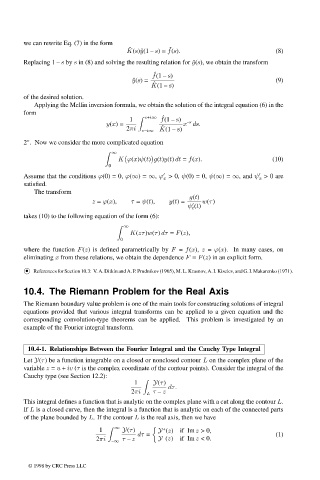Page 514 - Handbook Of Integral Equations
P. 514
we can rewrite Eq. (7) in the form
ˆ
ˆ
K(s) ˆy(1 – s)= f(s). (8)
Replacing 1 – s by s in (8) and solving the resulting relation for ˆy(s), we obtain the transform
ˆ
f(1 – s)
ˆ y(s)= (9)
ˆ
K(1 – s)
of the desired solution.
Applying the Mellin inversion formula, we obtain the solution of the integral equation (6) in the
form
c+i∞ ˆ
1 f(1 – s) –s
y(x)= x ds.
ˆ
2πi c–i∞ K(1 – s)
◦
2 . Now we consider the more complicated equation
∞
K ϕ(x)ψ(t) g(t)y(t) dt = f(x). (10)
0
Assume that the conditions ϕ(0) = 0, ϕ(∞)= ∞, ϕ >0, ψ(0) = 0, ψ(∞)= ∞, and ψ > 0 are
x x
satisfied.
The transform
g(t)
z = ϕ(x), τ = ψ(t), y(t)= w(τ)
ψ (t)
t
takes (10) to the following equation of the form (6):
∞
K(zτ)w(τ) dτ = F(z),
0
where the function F(z)isdefined parametrically by F = f(x), z = ϕ(x). In many cases, on
eliminating x from these relations, we obtain the dependence F = F(z) in an explicit form.
•
References for Section 10.3: V. A. Ditkin and A. P. Prudnikov (1965), M. L. Krasnov, A. I. Kiselev, and G. I. Makarenko (1971).
10.4. The Riemann Problem for the Real Axis
The Riemann boundary value problem is one of the main tools for constructing solutions of integral
equations provided that various integral transforms can be applied to a given equation and the
corresponding convolution-type theorems can be applied. This problem is investigated by an
example of the Fourier integral transform.
10.4-1. Relationships Between the Fourier Integral and the Cauchy Type Integral
Let Y(τ) be a function integrable on a closed or nonclosed contour L on the complex plane of the
variable z = u + iv (τ is the complex coordinate of the contour points). Consider the integral of the
Cauchy type (see Section 12.2):
1 Y(τ)
dτ.
2πi L τ – z
This integral defines a function that is analytic on the complex plane with a cut along the contour L.
If L is a closed curve, then the integral is a function that is analytic on each of the connected parts
of the plane bounded by L. If the contour L is the real axis, then we have
+
1 ∞ Y(τ) Y (z)if Im z >0,
dτ = – (1)
2πi τ – z Y (z) if Im z <0.
–∞
© 1998 by CRC Press LLC
© 1998 by CRC Press LLC
Page 496

